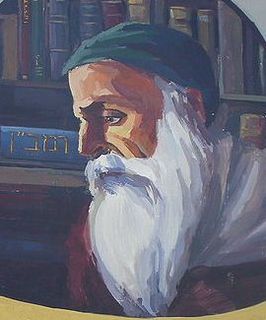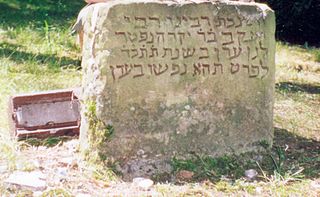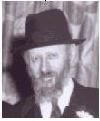Related Research Articles

Moses ben Nachman, commonly known as Nachmanides, and also referred to by the acronym Ramban and by the contemporary nickname Bonastruc ça Porta, was a leading medieval Jewish scholar, Sephardic rabbi, philosopher, physician, kabbalist, and biblical commentator. He was raised, studied, and lived for most of his life in Girona, Catalonia. He is also considered to be an important figure in the re-establishment of the Jewish community in Jerusalem following its destruction by the Crusaders in 1099.

The Tosafot,Tosafos or Tosfot are medieval commentaries on the Talmud. They take the form of critical and explanatory glosses, printed, in almost all Talmud editions, on the outer margin and opposite Rashi's notes.
Nissim ben Reuven of Girona, Catalonia was an influential talmudist and authority on Jewish law. He was one of the last of the great Spanish medieval Talmudic scholars. He is also known by his Hebrew acronym, the RaN, or else with the definite article HaRaN, as well as by the name RaNbaR, the Hebrew acronym of his full name, including his father's name, Reuven, and also by Nissim Gerondi.
Rishonim were the leading rabbis and poskim who lived approximately during the 11th to 15th centuries, in the era before the writing of the Shulchan Aruch and following the Geonim. Rabbinic scholars subsequent to the Shulkhan Arukh are generally known as acharonim.

Yitzchak Meir Rotenberg-Alter , 1799 – 10 March 1866, was the first Rebbe of the Ger Hasidic dynasty, which he founded in the town of Góra Kalwaria, Poland. He headed the Kupath Rabbi Meir Baal Haness Kollel Polen (Poland) Varsha (Warsaw). He was also known as The Chiddushei HaRim for his Torah writings, and was sometimes fondly called Reb Itche Meir (Yiddish) by his followers.
Yom Tov ben Abraham of Seville commonly known by the Hebrew acronym Ritva, was a medieval rabbi and rosh yeshiva of the Yeshiva of Seville, known for his commentaries on the Talmud.

Shlomo ben Avraham ibn Aderet was a medieval rabbi, halakhist, and Talmudist. He is widely known as the Rashba, the Hebrew acronym of his title and name: Rabbi Shlomo ben Avraham.

Bava Batra is the third of the three Talmudic tractates in the Talmud in the order Nezikin; it deals with a person's responsibilities and rights as the owner of property. It is part of Judaism's oral law. Originally it, together with Bava Kamma and Bava Metzia, formed a single tractate called Nezikin.

Yaakov ben Yakar was a German Talmudist. He flourished in the first half of the 11th century. He was a pupil of Gershom ben Judah in Mainz, and is especially known as the teacher of Rashi, who characterizes him as Mori HaZaken.
Abraham ben Isaac of Narbonne (c. 1080-85 – 1158) was a Provençal rabbi, also known as Raavad II, and author of the halachic work Ha-Eshkol.
Shem Tov ben Abraham ibn Gaon was a Spanish Talmudist and kabbalist.
Simeonben Gamliel II was a Tanna of the third generation and president of the Great Sanhedrin. He was the son of Gamaliel II.
Zechariah ben Judah Aghmati, also spelled Agamati, was a Rabbi and Talmudist who lived from 1120 CE - 1195 CE in Morocco.

Sifrei Kodesh, commonly referred to as sefarim, or in its singular form, sefer, are books of Jewish religious literature and are viewed by religious Jews as sacred. These are generally works of Torah literature, i.e. Tanakh and all works that expound on it, including the Mishnah, Midrash, Talmud, and all works of halakha, Musar, Hasidism, Kabbalah, or machshavah. Historically, sifrei kodesh were generally written in Hebrew with some in Judeo-Aramaic or Arabic, although in recent years, thousands of titles in other languages, most notably English, were published. An alternative spelling for 'sefarim' is seforim.
Rabbi Charles Ber Chavel was a rabbi and scholar who, most notably, published critical editions of medieval Jewish commentators.
Isaac ben Abraham, also called Rabbi Isaac ha-Baḥur and by its Hebrew acronym RIBA (ריב"א) or RIẒBA (ריצב"א), was a tosafist of the late twelfth and early thirteenth centuries.

Zechariah Elefant was a rabbi, author, publisher, and book salesman.
References
- 1 2 3 4 "Judah ben Yakar". Encyclopaedia Judaica. Retrieved 18 July 2017.
- ↑ Lekutot HaRamban, Pesachim 117b s.v. veani omer
- ↑ For example: Chiddushei HaRamban to Kiddushin 22a, 26a, 27a, 65b, 75b; Chiddushei haRashba Bava Batra 82a; Chiddushei HaRitva Bava Batra 82b; and many others
- ↑ Shut HaRashbash, 89
- ↑ Shut Harashba 1:523; Tashbetz, Magen Avod 4:11 (p.67)
- ↑ שלם יהלום, ר' יהודה בר יקר – תולדותיו ומקומו במשנת הרמב"ן, סידרא יז, תשס"א-תשס"ב, עמ' 88.
- ↑ גרשם שלום, "לחקר קבלת רבי יצחק בן יעקב הכהן" תרביץ ג תרצ"ב, עמ' 277; משה אידל רמב"ן: קבלה הלכה ומנהיגות רוחנית, תרביץ סד, תשנ"ה, עמ' 542; חביבה פדיה, הרמב"ן - התעלות: זמן מחזורי וטקסט קדוש תל אביב תשס"ג עמ' 89, הע' 5.